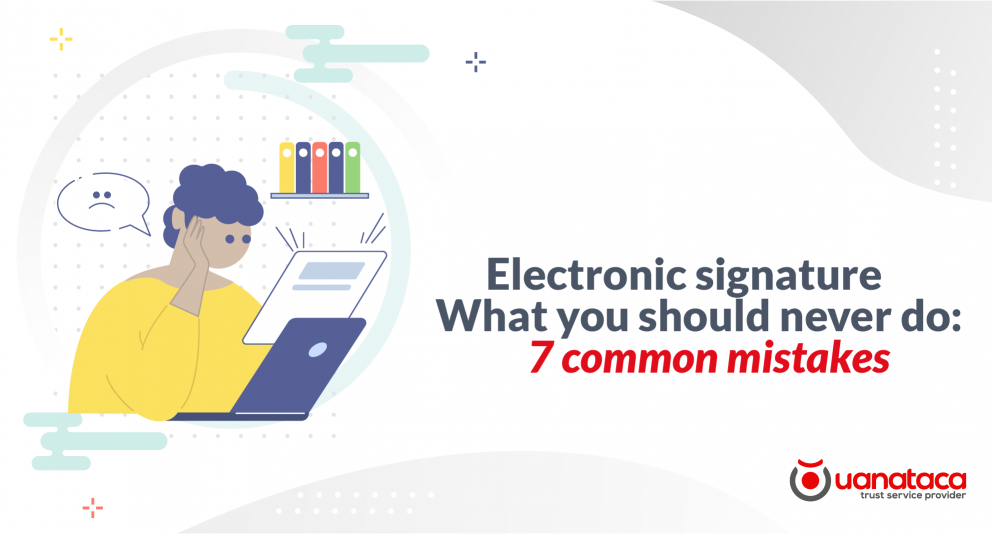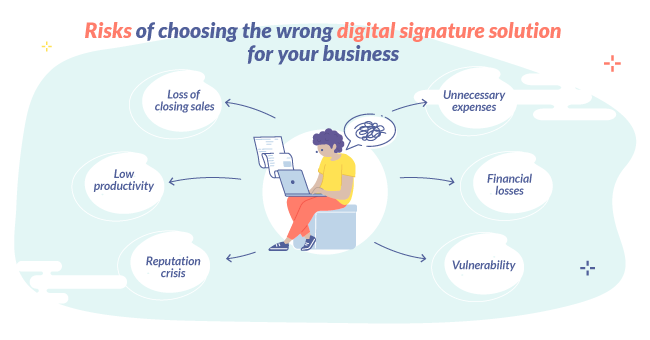
The demand for electronic signatures is intensifying. Faster and easier to use remain the main arguments in the choice of an electronic signature solution. But as companies increasingly conduct more and more transactions remotely, they must also ensure that the process is secure from start to finish and offer maximum legal guarantees.
Whether you are looking for an electronic signature solution for your business or you already have one, you should know what mistakes to avoid when choosing a solution, as well as identify whether you should continue with the current one. We tell you about them in this post.
Why e-signatures have become a critical factor in business
Investing in technology is an excellent way to save time and reduce effort. Tools such as electronic signatures are intended to make processes more efficient. It can also help you automate, simplify or even eliminate certain tasks, in addition to adding value to your product or service offering. Therefore, when choosing a signature solution for your business, you should not rush into anything.

If we make the right choice, the electronic signature will become an essential element for the company to achieve the objectives of growth, evolution and improvement over time, boosting its development, preventing it from losing competitiveness and maintaining high levels of customer consideration.
On the other hand, if we do not take into account some fundamental aspects such as the security and guarantees of the signature, we risk exposing our business to problems of various kinds depending on the shortcomings of the type of signature or the solution chosen.

In the business world, the financial sector is one of the most exposed to the consequences of a poor choice of electronic signature. In Spain, a recent Supreme Court ruling has set precedents after confirming the sanction imposed by the Spanish Data Protection Agency on a financial institution for lack of diligence in the identification of a client.
There are also other examples of sanctions in the financial sector. This is the case of a judgment that absolves the defendant of the payment of a credit granted by a company, formalized by means of a contract signed through a well-known commercial platform.
In both cases, the entities had to face a heavy financial penalty. In the long term, they need to continue working to reverse the damage caused by the reputation crisis, as the reputation and trust of customers is one of the most valuable assets in the financial sector.
7 common mistakes to avoid when choosing an electronic signature solution
1.- Choosing the wrong type of signature. There is an appropriate type of signature for each use case. The eIDAS regulation defines 3 types of signatures, differentiated mainly by their legal guarantees and security level. Of the 3 types, the qualified electronic signature is legally the most robust and offers the highest evidentiary quality.
It is followed by the advanced electronic signature, which offers an intermediate level of security. It is very appropriate in those cases where it is necessary to enjoy legal and evidentiary value but the highest level is not necessary.
As for the simple signature, it is the lowest level of security and the one that provides the least legal guarantees. It is the most basic type of signature and does not allow the signature to be linked to the signatory.
Since the electronic signature is the means to provide legal value and evidentiary quality to documents, it is necessary to analyze the use case and assess the level of risk we are willing to assume.
2.- Do not value the supplier's particular guarantees and experience. At some point and for certain cases such as the presentation of the electronic signature in a judicial process, it is possible that we may need the support of the provider through additional documents.
Uanataca, as a Qualified Trust Service Provider with a solid track record, provides its clients with qualified electronic signature services with official opinions for their presentation in court. In this way, Uanataca becomes a trusted ally in the event of possible litigation.
3. Contracting a solution that is too complex and difficult to use. If the signature system used cannot be used by the users in a simple way, the goals will not be achieved with effectiveness, efficiency and satisfaction in a specific context of use.
The consequences can range from significant losses in the customer conversion rate to delays in the signing of projects that may be critical to the company's development.
4.- Choosing a non-scalable solution with standard rates. The current context requires flexible solutions that allow companies to react quickly to changes in the market and develop smoothly. But non-scalable e-signature solutions can slow down business growth abruptly.
Uanataca's scalable solutions provide the ability to react and adapt without losing service quality. How is this achieved? With different types of signature and complementary services, which are adapted to each use case.
In addition to the advantage of being scalable, there is the pay-per-use model. Far from standard rates, this system allows companies to pay only for what is actually consumed, giving them greater control over costs.
5.- Failure to guarantee the protection of information. Signed documents may contain different personal and/or sensitive data that must be protected. An example of this can be found in the healthcare sector, where sensitive patient data is handled on a daily basis.
In any case, it is necessary to prevent and avoid unauthorized disclosure of information. To do this, integrate solutions that guarantee maximum confidentiality: solutions such as those of Uanataca, which do not allow the reconstruction of documents signed outside the company.
6.- That the solution is not compatible. Solutions that do not allow identity verification, authentication and verification of the authority of the signer of an electronic document should be avoided.
7.- Non-compliance with regulations. The eIDAS trust services are those integrated and audited under the European Regulation No. 910/2014 (eIDAS) Its use offers maximum guarantees, covered under the regulatory framework of trust.

In conclusion, the choice of an appropriate signature solution depends to a large extent on the growth of the business. It is important to look not only for the fastest, but also for legal safeguards without sacrificing the best user experience.
A well-designed signature process, supported by eIDAS-regulated trusted services, not only prevents legal risks, but also reduces them. Likewise, solutions tailored to companies promote business development through efficiency, effectiveness and user delight with memorable experiences.